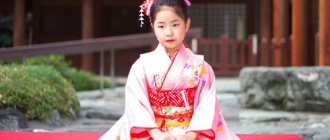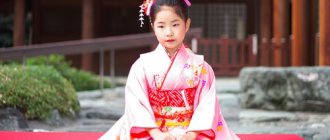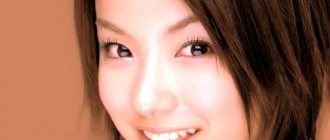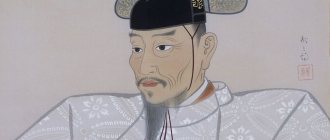JAPANESE NAMES, SURNAMES AND THEIR MEANINGS
Japanese names consist of a surname followed by a given name, and are usually written in kanji.
However, parents sometimes use the Japanese syllabaries hiragana and katakana to write their children's names. Moreover, in 1985, the list of officially permitted characters for writing names was expanded and now you can use Latin characters (Romanji), hentaiganu, man'yogana (syllabary alphabet), as well as special characters and symbols like * % $ ^ and the like. But in practice, hieroglyphs are almost always written. In the past, people in Japan were the property of the emperor, and their surname reflected their role in government. For example, Otomo (大友 - “great friend, comrade”). Names were also given to let people know that the person had done some great achievement, made a contribution, and the like.
Before the Meiji Restoration 明治維新 (Meiji Ishin), ordinary people did not have surnames, but instead used the name of their place of birth when necessary. For example, a person named Ichiro 一郎 might introduce himself as: “Ichiro from Asahi Village, Musashi Province.” Merchants used the names of their stores or brands. For example, a merchant named Denbei 伝兵衛, owner of Sagamiya 相模屋, could introduce himself as "Sagamiya Denbei". Peasants could name themselves after their father (for example: Yusuke 祐介, whose father was called Haruto 陽翔, could say: “Yusuke, son of Haruto”).
After the Meiji Restoration, the government ordered all commoners to create a surname for themselves as part of a plan to modernize and westernize. Some people chose historical names, others simply made them up, for example by fortune telling, or turned to priests to choose a surname. This explains the fact that in Japan there are many different surnames, both in pronunciation and spelling, and creates difficulties in reading.
Japanese surnames are extremely diverse, with an estimated over 100,000 different surnames. Typical, most common Japanese surnames include Sato (佐藤), Suzuki (铃木), and Takahashi (高桥). However, Japanese surnames vary in prevalence in different regions of Japan. For example, the surnames Chinen (知念), Higa (比嘉), and Shimabukuro (岛袋) are common in Okinawa, but not in other parts of Japan. This is due mainly to the differences between the language and culture of the people of Yamato and Okinawa.
Many Japanese surnames come from characteristic features of the rural landscape, for example: Ishikawa (石川) means “stone river”, Yamamoto (山本) means “base of the mountain”, Inoue (井上) means “above the well”. Most Japanese surnames refer to various rural settings. The following table provides a list of the most common Japanese surnames along with the characters, reading and their meaning in Russian.
| № | Surnames | Writing | Meanings of hieroglyphs |
| 1 | Sato: | 佐藤 | assistant+wisteria |
| 2 | Suzuki | 鈴木 | bell (bell) + tree |
| 3 | Takahashi | 高橋 | high+bridge |
| 4 | Tanaka | 田中 | rice field+middle |
| 5 | Watanabe | 渡辺/渡邊 | cross over + surroundings |
| 6 | Ito: | 伊藤 | I+wisteria |
| 7 | Yamamoto | 山本 | mountain+base |
| 8 | Nakamura | 中村 | middle+village |
| 9 | Kobayashi | 小林 | small forest |
| 10 | Kato: | 加藤 | add+wisteria |
| 11 | Yoshida | 吉田 | happiness+rice field |
| 12 | Yamada | 山田 | mountain+rice field |
| 13 | Sasaki | 佐々木 | helpers+tree |
| 14 | Yamaguchi | 山口 | mountain+mouth, entrance |
| 15 | Saito: | 斎藤/齋藤 | purification (religious) + wisteria |
| 16 | Matsumoto | 松本 | pine+base |
| 17 | Inoe | 井上 | well+top |
| 18 | Kimura | 木村 | tree+village |
| 19 | Hayashi | 林 | forest |
| 20 | Shimizu | 清水 | pure water |
| 21 | Yamazaki/ Yamasaki | 山崎 | mountain+cape |
| 22 | Mori | 森 | forest |
| 23 | Abe | 阿部 | corner, shadow; sector; |
| 24 | Ikeda | 池田 | pond+rice field |
| 25 | Hashimoto | 橋本 | bridge+base |
| 26 | Yamashita | 山下 | mountain+under, bottom |
| 27 | Ishikawa | 石川 | stone+river |
| 28 | Nakajima/Nakashima | 中島 | middle+island |
| 29 | Maeda | 前田 | behind + rice field |
| 30 | Fujita | 藤田 | wisteria+rice field |
| 31 | Ogawa | 小川 | small river |
| 32 | Goto: | 後藤 | behind, future+wisteria |
| 33 | Okada | 岡田 | hill+rice field |
| 34 | Hasegawa | 長谷川 | long+valley+river |
| 35 | Murakami | 村上 | village+top |
| 36 | Condo | 近藤 | close+wisteria |
| 37 | Ishii | 石井 | stone+well |
| 38 | Saito: | 斉藤/齊藤 | equal+wisteria |
| 39 | Sakamoto | 坂本 | slope+base |
| 40 | Iendo: | 遠藤 | distant+wisteria |
| 41 | Aoki | 青木 | green, young+tree |
| 42 | Fuji | 藤井 | wisteria+well |
| 43 | Nishimura | 西村 | west+village |
| 44 | Fukuda | 福田 | happiness, prosperity + rice field |
| 45 | Oota | 太田 | large+rice field |
| 46 | Miura | 三浦 | three bays |
| 47 | Okamoto | 岡本 | hill+base |
| 48 | Matsuda | 松田 | pine+rice field |
| 49 | Nakagawa | 中川 | middle+river |
| 50 | Nakano | 中野 | middle+[uncultivated] field; plain |
| 51 | Harada | 原田 | plain, field; steppe+rice field |
| 52 | Fujiwara | 藤原 | wisteria + plain, field; steppe |
| 53 | It | 小野 | small+[uncultivated] field; plain |
| 54 | Tamura | 田村 | rice field+village |
| 55 | Takeuchi | 竹内 | bamboo+inside |
| 56 | Kaneko | 金子 | gold+child |
| 57 | Vada | 和田 | harmony+rice field |
| 58 | Nakayama | 中山 | middle+mountain |
| 59 | Isis | 石田 | stone+rice field |
| 60 | Ueda/Ueta | 上田 | top+rice field |
| 61 | Morita | 森田 | forest+rice field |
| 62 | Hara | 原 | plain, field; steppe |
| 63 | Shibata | 柴田 | brushwood+rice field |
| 64 | Sakai | 酒井 | alcohol+well |
| 65 | Kudo: | 工藤 | worker+wisteria |
| 66 | Yokoyama | 横山 | side, side of the mountain |
| 67 | Miyazaki | 宮崎 | temple, palace + cape |
| 68 | Miyamoto | 宮本 | temple, palace+base |
| 69 | Uchida | 内田 | inside+rice field |
| 70 | Takagi | 高木 | tall tree |
| 71 | Ando: | 安藤 | calm+wisteria |
| 72 | Taniguchi | 谷口 | valley+mouth, entrance |
| 73 | Oono | 大野 | large+[uncultivated] field; plain |
| 74 | Maruyama | 丸山 | round+mountain |
| 75 | Imai | 今井 | now+well |
| 76 | Takada/ Takata | 高田 | high+rice field |
| 77 | Fujimoto | 藤本 | wisteria+base |
| 78 | Takeda | 武田 | military+rice field |
| 79 | Murata | 村田 | village+rice field |
| 80 | Ueno | 上野 | top+[uncultivated] field; plain |
| 81 | Sugiyama | 杉山 | Japanese cedar+mountain |
| 82 | Masuda | 増田 | increase+rice field |
| 83 | Sugawara | 菅原 | sedge+plain, field; steppe |
| 84 | Hirano | 平野 | flat+[uncultivated] field; plain |
| 85 | Ootsuka | 大塚 | big+hill |
| 86 | Kojima | 小島 | small+island |
| 87 | Chiba | 千葉 | thousand sheets |
| 88 | Kubo | 久保 | long+maintain |
| 89 | Matsui | 松井 | pine+well |
| 90 | Iwasaki | 岩崎 | rock+cape |
| 91 | Sakurai | 桜井/櫻井 | sakura+well |
| 92 | Kinoshita | 木下 | tree+under, bottom |
| 93 | Noguchi | 野口 | [uncultivated] field; plain+mouth, entrance |
| 94 | Matsuo | 松尾 | pine+tail |
| 95 | Nomura | 野村 | [uncultivated] field; plain+village |
| 96 | Kikuchi | 菊地 | chrysanthemum+earth |
| 97 | Sano | 佐野 | assistant+[uncultivated] field; plain |
| 98 | Oonisi | 大西 | big west |
| 99 | Sugimoto | 杉本 | Japanese cedar+roots |
| 100 | Arai | 新井 | new well |
| 101 | Hamada | 浜田/濱田 | shore+rice field |
| 102 | Ichikawa | 市川 | city+river |
| 103 | Furukawa | 古川 | old river |
| 104 | Mizuno | 水野 | water+[uncultivated] field; plain |
| 105 | Komatsu | 小松 | small pine |
| 106 | Shimada | 島田 | island+rice field |
| 107 | Koyama | 小山 | small mountain |
| 108 | Takano | 高野 | high+[uncultivated] field; plain |
| 109 | Yamauchi | 山内 | mountain+inside |
| 110 | Nishida | 西田 | west+rice field |
| 111 | Kikuchi | 菊池 | chrysanthemum+pond |
| 112 | Nishikawa | 西川 | west+river |
| 113 | Igarashi | 五十嵐 | 50 storms |
| 114 | Kitamura | 北村 | north+village |
| 115 | Yasuda | 安田 | calm+rice field |
| 116 | Nakata/ Nakada | 中田 | middle+rice field |
| 117 | Kawaguchi | 川口 | river+mouth, entrance |
| 118 | Hirata | 平田 | flat+rice field |
| 119 | Kawasaki | 川崎 | river+cape |
| 120 | Iida | 飯田 | boiled rice, food+rice field |
| 121 | Yoshikawa | 吉川 | happiness+river |
| 122 | Honda | 本田 | base+rice field |
| 123 | Kubota | 久保田 | long+maintain+rice field |
| 124 | Sawada | 沢田/澤田 | swamp+rice field |
| 125 | Tsuji | 辻 | Street |
| 126 | Seki | 関/關 | Outpost; barrier |
| 127 | Yoshimura | 吉村 | happiness+village |
| 128 | Watanabe | 渡部 | cross over + part; sector; |
| 129 | Iwata | 岩田 | rock+rice field |
| 130 | Nakanishi | 中西 | west+middle |
| 131 | Hattori | 服部 | clothing, subordinate+ part; sector; |
| 132 | Higuchi | 樋口 | gutter; drain+mouth, entrance |
| 133 | Fukushima | 福島 | happiness, well-being + island |
| 134 | Kawakami | 川上 | river+top |
| 135 | Nagai | 永井 | eternal well |
| 136 | Matsuoka | 松岡 | pine+hill |
| 137 | Taguchi | 田口 | rice floor+mouth |
| 138 | Yamanaka | 山中 | mountain+middle |
| 139 | Morimoto | 森本 | wood+base |
| 140 | Tsuchiya | 土屋 | land+house |
| 141 | I but | 矢野 | arrow+[uncultivated] field; plain |
| 142 | Hirose | 広瀬/廣瀬 | wide fast current |
| 143 | Ozawa | 小沢/小澤 | small swamp |
| 144 | Akiyama | 秋山 | autumn+mountain |
| 145 | Ishihara | 石原 | stone + plain, field; steppe |
| 146 | Matsushita | 松下 | pine+under, bottom |
| 147 | Woman | 馬場 | horse+place |
| 148 | Oohashi | 大橋 | big bridge |
| 149 | Matsuura | 松浦 | pine+bay |
| 150 | Yoshioka | 吉岡 | happiness+hill |
| 151 | Koike | 小池 | small+pond |
| 152 | Asano | 浅野/淺野 | small+[uncultivated] field; plain |
| 153 | Araki | 荒木 | wild+tree |
| 154 | Ookubo | 大久保 | big+long+support |
| 155 | Kumagai | 熊谷 | bear+valley |
| 156 | But yes | 野田 | [uncultivated] field; plain+rice field |
| 157 | Tanabe | 田辺/田邊 | rice field+surroundings |
| 158 | Kawamura | 川村 | river+village |
| 159 | Hoshino | 星野 | star+[uncultivated] field; plain |
| 160 | Ootani | 大谷 | big valley |
| 161 | Kuroda | 黒田 | black rice field |
| 162 | Hori | 堀 | channel |
| 163 | Ozaki | 尾崎 | tail + cape |
| 164 | Mochizuki | 望月 | full moon |
| 165 | Nagata | 永田 | eternal rice field |
| 166 | Naito | 内藤 | inside+wisteria |
| 167 | Matsumura | 松村 | pine+village |
| 168 | Nishiyama | 西山 | west+mountain |
| 169 | Hirai | 平井 | level well |
| 170 | Ooshima | 大島 | big Island |
| 171 | Iwamoto | 岩本 | rock+base |
| 172 | Katayama | 片山 | piece+mountain |
| 173 | Homma | 本間 | base+space, room, luck |
| 174 | Hayakawa | 早川 | early+river |
| 175 | Yokota | 横田 | side+rice field |
| 176 | Okazaki | 岡崎 | hill+cape |
| 177 | Arai | 荒井 | wild well |
| 178 | Ooisi | 大石 | big Stone |
| 179 | Kamata | 鎌田 | sickle, scythe + rice field |
| 180 | Narita | 成田 | form + rice field |
| 181 | Miyata | 宮田 | temple, palace+rice field |
| 182 | Oh yeah | 小田 | small rice field |
| 183 | Ishibashi | 石橋 | stone+bridge |
| 184 | Ko:but | 河野 | river+[uncultivated] field; plain |
| 185 | Shinohara | 篠原 | low-growing bamboo + plain, field; steppe |
| 186 | Suto/Sudo | 須藤 | definitely+wisteria |
| 187 | Hagiwara | 萩原 | bicolor lespedeza + plain, field; steppe |
| 188 | Takayama | 高山 | high mountain |
| 189 | Oosawa | 大沢/大澤 | big swamp |
| 190 | Konishi | 小西 | small+west |
| 191 | Minami | 南 | south |
| 192 | Kurihara | 栗原 | chestnut + plain, field; steppe |
| 193 | Ito | 伊東 | that, he+east |
| 194 | Matsubara | 松原 | pine+plain, field; steppe |
| 195 | Miyake | 三宅 | three houses |
| 196 | Fukui | 福井 | happiness, well-being + well |
| 197 | Oomori | 大森 | big forest |
| 198 | Okumura | 奥村 | deep (hidden)+village |
| 199 | Oka | 岡 | Hill |
| 200 | Uchiyama | 内山 | inside+mountain |
In general, surnames usually have some patterns and their reading does not cause any particular difficulties, but Japanese names are very diverse both in pronunciation and spelling.
Although many typical Japanese names can be easily written and read, many parents choose names with unusual characters or pronunciation. Such names do not have a clear reading or spelling.
The tendency to give such names has especially appeared since 1990. For example, the popular name for boys 大翔 is traditionally read as Hiroto, but alternative readings of this name have appeared: Haruto, Yamato, Daito, Taiga, Sora, Taito, Masato, and all of them have come into use.
Each hieroglyph has up to three main types of readings, each of which can have several more options. Plus, there are other rarer types of reading hieroglyphs in names.
For example, the character love (愛) has the following reading types (according to the dictionary). Chinese reading (on'yomi) - ai Japanese reading (kun'yomi) - ito (shii) Special type of reading used in names (nanori): a, ashi, e, kana mana, megu, megumi, yoshi
Hieroglyph child (子): onyomi - shi, su, tsu kunyomi - ko, ne nanori: - i, ki, gi, ku, ke
Thus, we get many options for reading the name, written in the same hieroglyphs! The dictionary gives the following reading options for a name written in the characters love+child (愛子): Aiko, Aisu, Akiko, Ako, Ayashi, Itoko, Kanako, Chikako, Tsuneko, Naruko, Mako, Manako, Manami, Megumiko, Yoshiko, etc. .
How then to read the hieroglyphs in names in Japanese? Nothing complicated. When meeting Japanese people, they usually exchange business cards (meisi), pronouncing their first and last names - at this moment you need to carefully listen to the only correct pronunciation of the name of the person you are communicating with, and if you didn’t hear it, be sure to clarify.
In addition, hieroglyphs on business cards are often signed using one of the Japanese alphabet or Latin characters. Names are signed in a similar way in literature and in film subtitles.
Male names often end in –ro: (郎 “son”, but also 朗 – “clear, bright”, e.g. Ichiro), –ta (太 “big, thick,” e.g. Kenta), contain ichi (一 “ first [son]"), ji (二 - "second [son]", or 次 - "next", for example, Jiro), or dai (大 - "great, great", for example, Daiichi).
In addition, in male names with two hieroglyphs, hieroglyphs that indicate a male name are often used: 夫 (o) - “husband”, 男 (o) - “man”, 雄 (o) - “hero”, 朗 (ro:) - “ cheerful”, 樹 (ki) - “tree”, 助 (suke) - “helper” and many others.
Japanese female names
Most Japanese female names have an abstract meaning. Typically, such names use characters such as 美 (mi), which means “beauty,” 愛 (ai) — “love,” 安 (an) — “calmness,” 知 (ti) — “mind,” 優 (yu: ) - “tenderness”, 真 (ma) - “truth” and others. As a rule, names with similar hieroglyphs are given to girls as a wish to have these qualities in the future.
Another type of female name uses animal or plant hieroglyphs. Names with animal characters 虎 (tora) - "tiger" or 鹿 (shika) - "deer" were considered to promote health, but now such names are considered old-fashioned and are rarely used, with the exception of the character 鶴 (tsuru) - "crane". Names containing hieroglyphs associated with the plant world are still often used, for example 花 (hana) - “flower”, 稲 (ine) - “rice”, 菊 (kiku) - “chrysanthemum”, 竹 (take) - “ bamboo", 桃 (momo) - "peach", 柳 (yanagi) - "willow", and others.
There are also names with numerals, but they are very few in number and are quite rare. Such names most likely come from the old tradition of naming girls of noble families by birth order. Currently, the following numerals are usually used: 千 (ti) - “thousand”, 三 (mi) - “three”, 五 (go) - “five” and 七 (nana) - “seven”.
Quite often there are names with meanings of seasons, natural phenomena, time of day and many others. For example: 雪 (yuki) - “snow”, 夏 (natsu) - “summer”, 朝 (asa) - “morning”, 雲 (kumo) - “cloud”.
It happens that instead of hieroglyphs, syllabic alphabet are used. Moreover, the recording of such a name is constant, unlike words that can be written in different ways (in alphabet, hieroglyphs, or mixed). For example, if a woman’s name is written in hiragana, then it will always be written that way, although in terms of its meaning it can be written as a hieroglyph.
By the way, it is very fashionable and exotic to use foreign names instead of classic female names: あんな - Anna, まりあ - Maria, えみり - Emiri, れな - Rena, りな - Rina and others.
A typical Japanese female name ends in the character 子 (ko) - “child” (Maiko, Haruko, Hanako, Takako, Yoshiko, Asako, Naoko, Yumiko). And currently, about a quarter of Japanese female names end in -ko. Until 1868, this name was used only by members of the imperial family, but after the revolution this name became very popular, especially in the mid-20th century. However, after 2006, this indicator of a female name ceased to be fashionable due to the emergence of a new fashion for names, and many girls eliminated it from their names and began to call them simply Yumi, Hana, Haru, etc.
The second most frequently used character is 美 (mi) - “beauty”. Unlike many other name gender indicators, it can occur anywhere in a name (Fumiko, Mie, Kazumi, Miyuki).
Also, about 5% of Japanese female names contain the component 江 (e) - “bay” (Mizue, 廣江 Hiroe).
Many other characters are also used to indicate that this is a female name, each of which is found in less than 4% of female names: 代 (yo) - “era”, 香 (ka) - “smell”, 花 (ka) - “flower” , 里 (ri) - “measure of the length of ri” (often used phonetically), 奈 (na) - used phonetically, 織 (ori) - “fabric” and others.
However, there are female names consisting of several hieroglyphs that do not have indicators that this is a female name. Examples: 皐月 Satsuki, 小巻 Komaki.
Popular Japanese names and their meanings
Since 2005, the Japanese company Benesse Corporation has annually published a ranking of popular Japanese names among newborns. In 2011, from January 1 to May 31, 34,500 people were born, of which 17,959 were boys and 16,541 were girls.
The following are popular Japanese names and their meanings, as well as transcription and the number of children born with that name.
Popular Japanese male names
| № | Hieroglyphs | Reading | Meaning of hieroglyphs | Number of boys | % boys |
| 1 | 大翔 | Hiroto | big + flying | 119 | 0,66 |
| 2 | 蓮 | Ren | lotus | 113 | 0,63 |
| 3 | 悠真 | Yuma | calm+honest | 97 | 0,54 |
| 4 | 颯太 | So:ta | dashing+big, fat, great | 92 | 0,51 |
| 5 | 蒼空 | Sora | blue sky | 84 | 0,47 |
| 6 | 翔太 | Sho:ta | flying+big, thick, great | 79 | 0,44 |
| 7 | 大和 | Yamato | big+peaceful,soft, gentle | 73 | 0,41 |
| 8 | 陽斗 | Haruto | solar+capacity measure, bucket | 79 | 0,44 |
| 9 | 陸 | Riku | dry land, earth | 64 | 0,36 |
| 10 | 陽翔 | Haruto | sunny, positive + flying | 64 | 0,36 |
Popular Japanese girl names
| № | Hieroglyphs | Reading | Meaning of hieroglyphs | Number of girls | % girls |
| 1 | 結衣 | Yui | tie+clothes | 109 | 0,66 |
| 2 | 葵 | Aoi | mallow, marshmallow, geranium, etc. | 104 | 0,63 |
| 3 | 結愛 | Yua | connect+love | 102 | 0,62 |
| 4 | 凛 | Rin | majestic; impressive | 100 | 0,60 |
| 5 | 陽菜 | Hina | sunny, positive + vegetables, greens | 99 | 0,60 |
| 6 | 結菜 | Yuina | connect, form, finish + vegetable, greens | 99 | 0,60 |
| 7 | さくら | Sakura | Sakura | 74 | 0,45 |
| 8 | 愛菜 | Mana | love + vegetable, greens | 74 | 0,45 |
| 9 | 咲希 | Saki | bloom+rarely, desire | 71 | 0,43 |
| 10 | 優奈 | Yu:na | excellent, graceful, friendly + phonetician | 66 | 0,40 |
Japanese pet names/nicknames/nicknames
From each name you can form one or more diminutive names by adding the nominal suffix -chan or -kun to the stem. There are two types of name stems. One consists of the full name, such as Taro: -chan (Taro:), Kimiko-chan (Kimiko) and Yasunari-chan (Yasunari).
Another type of stem is an abbreviation of the full name. Ta:-chan (Taro:), Kii-chan (Kimiko), Ya:-chan (Yasunari), Ko:-kun, Ma:-kun, Sho:-chan, etc. The second type of diminutive name is of a more intimate nature (for example, between friends).
There are other ways to form diminutive names, for example, a girl with the name Megumi can be called Kei-chan, since the character with which the name Megumi begins (恵) can also be read as Kei.
The common Japanese practice of creating abbreviations, which involves combining the first two syllables of two words, is sometimes applied to names (usually celebrities).
For example, Kimura Takuya (木村拓哉), a famous Japanese actor and singer, becomes Kimutaku (キムタク). This is sometimes applied to foreign celebrities: Brad Pitt, whose full name in Japanese is Buraddo Pitto (ブラッド • ピット), is fairly well known as Burapi (ブラピ), and Jimi Hendrix is shortened to Jimihen (ジミヘン). Another slightly less common method is to double one or two syllables in a person's name. For example, Mamiko Noto may be called MamiMami.
Japanese names in Chinese
As a rule, Japanese names are written in hieroglyphs. And the Japanese, like many other things, borrowed hieroglyphs from the Chinese. Those. Japanese and Chinese will read the same character differently. For example, a Chinese will read 山田太郎 (Yamada Taro) approximately as “Shantien Tailang”, and 鳩山由紀夫 (Hatoyama Yukio) as “Jiushan Youjifu”. This is why the Japanese do not understand their names when they read them in Chinese.
Reading Japanese first and last names
Reading names in Japanese is very difficult. The hieroglyphs of one name can be read in different ways, and at the same time, the pronunciation of one name can also be written in different ways.
Japanese nominal suffixes
In Japan, when addressing a person, it is customary to use nominal suffixes when addressing a person’s surname or first name (usually the Japanese address each other by surname). You should not address a person without adding a nominal suffix, it will sound too familiar (much like Petrov, Ivanova). Only parents can address their young children this way, close friends (but even here different suffixes are usually used), etc. Therefore, as a rule, you need to use some kind of nominal suffix. There are quite a few of them, below are a few of the most common ones.
“-san” is a neutral polite suffix, very close to addressing people by name and patronymic. It can be used in almost any situation, especially in women's speech, where a woman can even call her husband with this nominal suffix. When addressing a stranger or colleague, you can safely use this Japanese suffix.
“-kun” - this suffix is close to addressing “you.” Those. used when communicating between people of equal social status (friends, colleagues, friends, classmates), seniors can also address juniors, bosses to subordinates, teachers to students in an informal setting. Usually the suffix -kun is used when addressing men, but a boss can also call a woman with the suffix -kun.
“-chan” is a Japanese diminutive nominal suffix used in close relationships (something like in Russian Nastenka, Katyusha, Vovochka). Usually used in relation to children or girlfriends. In relation to a man, this suffix is offensive; only a beloved girl or friends can call him this in a joking manner. Also, pet names often include the suffix -chan, for example, Ken-chan (the dog from the drama Kekkon dekinai otoko).
“-sama” is a suffix expressing great respect and reverence. For example, when addressing deities, or a fan to his idol, a servant to his master, or in official letters to his clients. Sometimes to express one’s arrogant attitude towards others when applying this suffix to oneself. Also used for sarcasm.
You can also often find the following suffixes: -sensei - when addressing teachers, doctors, scientists, politicians -senpai - when addressing an older, more experienced person (for example, at school to high school students) -kohai - on the contrary, when addressing those who less experienced, for example to his followers, but is usually used not as a suffix, but as a separate word.
Russian names in katakana
Russian names in Japanese will be written with syllables in katakana , similar to the original sound of the name. Problems in spelling a name can arise when faced with sounds that do not exist in the Japanese language.
Unlike the Russian language, there is no “l” sound in Japanese, so all foreign words (including names) that contain this sound will be written with “r”. For example, “Lena” in Japanese will sound and be written as “Rena”, and “Alexey” - “Arekusei”.
You also need o(ヴ), which was created specifically to denote the non-existent “v” sound in foreign words. In Russian, it is quite common and many Russian names are written with the letter “vu”. For example, the name “Vladimir” can be written like this: “Vuradimir”.
However, due to the difficulty of pronunciation, the Japanese prefer to replace the sound “v” with “b”. Thus, the name Valeria, for example, can be written in two ways: “Vuareria” and “Bareria”.
Sometimes in a name written in Japanese you can see the sign 「―」. It serves as an accent, lengthening the vowel sound in front. For example, the name "Irina" in Japanese can be written with this sign: "Iri:na", or 「イリーナ」.
Abbreviated names are also common in Russian. In most cases, such names will be written with additional syllables. For example, when writing “Dasha” or “Sasha”, the compound syllable “sha” (シャ) is used. And to write “Katya” or “Nastya” in Japanese, you will need to use “cha”(チャ). Thus, these names will sound and be written like this:
- “Dasha” (ダシャ);
- "Sasha" (サーシャ);
- "Katya" (カチャ);
- "Nastya" (ナスチャ).
Please note that there is no single correct spelling of your name in katakana. It may vary, since some sounds can be written in different syllables.








